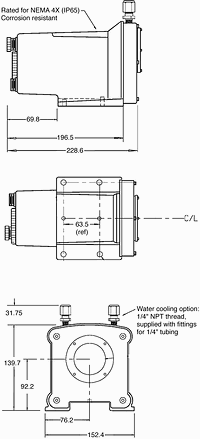
An infrared thermometer calculates temperature by using a model, or algorithm, that correlates measured infrared energy to temperature. The appropriate model for any given application depends on several factors, including the measured material and its size and emissivity properties, and the presence of any stray background infrared energy.
All three models, single-, dual-, and multiwavelength, make assumptions about these factors. Any deviation from these assumptions will result in a measurement error; therefore, the selection of the most appropriate temperature-measurement model is a critical sensor selection criterion.
Temperature measurement is complicated by the fact that the amount of infrared energy emitted by a surface is proportional to the emissivity as well as the temperature of the measured target. Therefore, any temperature measurement model must effectively address the issues associated with the emissivity of the measured target if an accurate temperature value is to be obtained.
Emissivity, or the tendency of a material to emit infrared energy, is a physical property of the measured material. Emissivity is defined as the percent of infrared energy emitted by an object as compared to the amount of infrared energy that would be emitted by a theoretically perfect emitter at that same temperature. For opaque objects, emissivity is the opposite of reflectivity (at the measured wavelength). A highly reflective material will have a low emissivity, and a non-reflective material will have a high emissivity. For some materials and applications, the emissivity is a constant value, while for others it can vary widely.

Single-wavelength infrared thermometers
A single-wavelength infrared thermometer assumes that the emissivity is constant and known. In addition, the single-wavelength model assumes that the optical path is unobstructed, and that the target fills the measured area. This is a valid assumption for many applications. Any change in emissivity will result in an error. The size of the error varies with wavelength and temperature, and with the percent change in emissivity at the measured wavelength. The lower the temperature, and the shorter the wavelength, the smaller the error for any given percent change in emissivity.
Single-wavelength sensors are available in a wide range of wavelengths. Short-wavelength single-wavelength sensors are used to minimise errors resulting from a change in emissivity or optical obstruction. These sensors are especially effective when measuring low temperature low-emissivity materials. Long-wavelength single-wavelength sensors provide broader temperature spans, and are generally lower in cost, but are significantly more sensitive to emissivity variation. Short wavelength sensors can view through common window materials, whereas longer wavelength sensors must view through more exotic window materials. In general, short wavelength sensors are less influenced by interference from hotter background sources.
Dual-wavelength infrared thermometers
Single-wavelength and dual-wavelength (ratio) models utilise general-purpose algorithms that are appropriate for a wide range of applications. There exists, however, a number of industrial applications for which these general-purpose algorithms are not appropriate. Unlike the general-purpose algorithms, there is no one multiwavelength algorithm. Each algorithm is designed to account for the unique emissivity character associated with a particular application.
Multiwavelength sensors are required for the measurement of materials for which the single and dual-wavelength sensors are not appropriate. Some of the more popular applications include the measurement of aluminium, brass, copper, stainless steel, chrome, tin and zinc. For each of these non-grey body materials, emissivity varies over time or from part to part; making single-wavelength sensors inappropriate, and emissivity varies differently at different wavelengths, making dual-wavelength (ratio) sensors inappropriate. Temperature Controls is the sole SA agent for Williamson products.
For more information contact Andy Brown, Temperature Controls, 011 791 6000, [email protected], www.tempcon.co.za
| Tel: | +27 11 791 6000 |
| Email: | [email protected] |
| www: | www.tempcon.co.za |
| Articles: | More information and articles about Temperature Controls |

© Technews Publishing (Pty) Ltd | All Rights Reserved